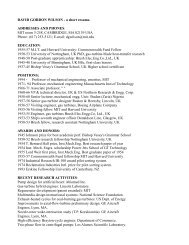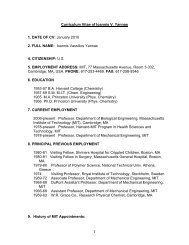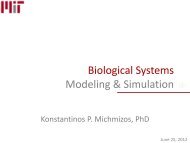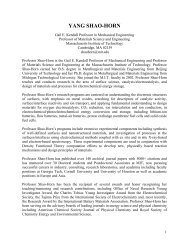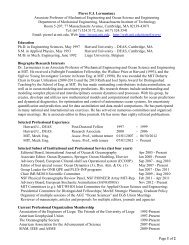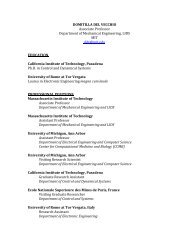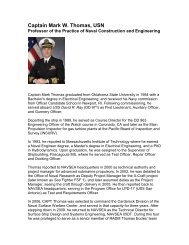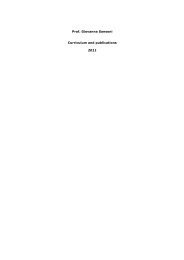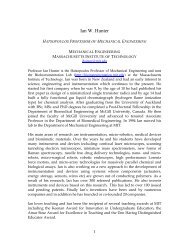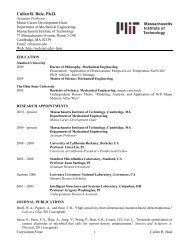Compound Noise - MIT Department of Mechanical Engineering
Compound Noise - MIT Department of Mechanical Engineering
Compound Noise - MIT Department of Mechanical Engineering
You also want an ePaper? Increase the reach of your titles
YUMPU automatically turns print PDFs into web optimized ePapers that Google loves.
388 J. SINGH ET AL.<br />
As discussed in a recent review paper by Robinson et al. 2 , research efforts in robust design have led to novel<br />
performance measures, new experimental designs, and alternatives to Taguchi’s methods building upon response<br />
surface methodology. One <strong>of</strong> the principal goals <strong>of</strong> recent research has been to reduce run sizes while still<br />
attaining good outcomes. The focus <strong>of</strong> this paper will be compound noise, which is also intended to reduce run<br />
sizes.<br />
<strong>Compound</strong> noise is a technique in which multiple noise factors are varied simultaneously as if they were a<br />
single noise factor. In most documented applications, an outer array <strong>of</strong> noise factors is replaced by the compound<br />
noise factor being varied between two levels. Taguchi 1 and Phadke 3 suggested forming compound noise factors<br />
based on the directionality <strong>of</strong> the noise factor effects thereby creating two conditions that represent, in some<br />
sense, opposite extremes. Du et al. 4 suggested forming compound noises based on the conditions <strong>of</strong> the two<br />
‘most probable points <strong>of</strong> inverse reliability’. This approach to compounding is better able to account for skew<br />
in the distribution <strong>of</strong> system performance. This new concept <strong>of</strong> compound noise, like Taguchi’s, is based on two<br />
‘extreme settings’ <strong>of</strong> noise factors.<br />
Hou 5 studied the conditions that will make compound noise yield robust settings for systems. Hou said<br />
‘extreme settings should exist for compound noise to work’. We find below that compound noise can be effective<br />
even when extreme settings do not exist. The conditions mentioned in ‘compound noise factor theory’ turn out<br />
to be the sufficient conditions. In later sections we extend the analysis to determine conditions under which<br />
compound noise will predict a robust setting. Hou’s formulation was limited to systems that had active effects<br />
up to two-factor interactions. We extend the formulation to systems that can have active effects up to three-factor<br />
interactions.<br />
<strong>Compound</strong> noise can be considered as an extension <strong>of</strong> supersaturated designs (SSD). This concept initially<br />
originated with a paper by Satterthwaite 6 . SSDs were assumed to <strong>of</strong>fer a potentially useful way to investigate<br />
many factors with few experiments. Holcomb and Carlyle 7 discussed the construction and evaluation <strong>of</strong> SSDs.<br />
Holcomb et al. 8 outlined the analysis <strong>of</strong> SSDs. <strong>Compound</strong> noise is an unbalanced SSD. Allen and Bernshteyn 9<br />
discussed the advantages <strong>of</strong> unbalanced SSDs in terms <strong>of</strong> performance and affordability. Heyden et al. 10 argued<br />
that SSDs can be used to estimate variance <strong>of</strong> response, which can be used as a measure <strong>of</strong> robustness rather<br />
than using it to find main effects. SSDs ‘do not allow estimation <strong>of</strong> the effects <strong>of</strong> the individual factors because<br />
<strong>of</strong> confounding between the main effects’. However, ‘estimation <strong>of</strong> the separate factor effects is not necessarily<br />
required’ in improving robustness. Using compound noise as a robust design method we try to estimate the<br />
robustness <strong>of</strong> the system at a given control factor setting. The setting that improves this estimate is taken as the<br />
predicted robust setting.<br />
The aim <strong>of</strong> this study is to explore the effectiveness <strong>of</strong> compound noise as a robust design method. <strong>Engineering</strong><br />
systems show certain regularities, one <strong>of</strong> which is the hierarchical ordering principle (see Wu and Hamada 11<br />
and Chipman et al. 12 ). We classified systems based on the hierarchical ordering principle. The classes are as<br />
follows.<br />
• Strong hierarchy systems are those that have only main effects and two-factor interactions active.<br />
Some small three-factor interactions might be present in such systems, but they are not active.<br />
• Weak hierarchy systems are those that also have active three-factor interactions.<br />
We apply compound noise to three strong hierarchy systems and three weak hierarchy systems and analyze<br />
robustness gain. There are three main questions we want to address in this paper.<br />
• Why is compound noise effective in achieving a robust setting in certain cases, but ineffective in other<br />
cases<br />
• How can we measure the effectiveness <strong>of</strong> a compound noise strategy<br />
• Do we need to know the directionality <strong>of</strong> noise factors to use compound noise<br />
We analyze a compound noise factor strategy for six case studies and explore reasons for the effectiveness or<br />
ineffectiveness <strong>of</strong> the strategy. We then present the conditions for compound noise to work. These conditions are<br />
an extension <strong>of</strong> Hou 5 . First, we present conditions for strong and weak hierarchy systems. Second, we present<br />
the effectiveness <strong>of</strong> the compound noise strategy in real scenarios using fractional factorial arrays for control<br />
Copyright c○ 2006 John Wiley & Sons, Ltd. Qual. Reliab. Engng. Int. 2007; 23:387–398<br />
DOI: 10.1002/qre



